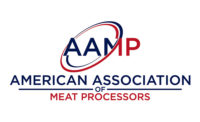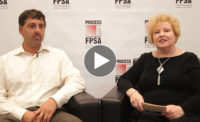In this video Q&A, Chris Young, Executive Director of AAMP, discusses how AAMP partnered with IFFA to bring the meat judging competition to the United States as well as the biggest challenges and opportunities for small processors.
Sam Gazdziak: We’re here with Chris Young, the Executive Director for the American Association of Meat Processors (AAMP). Chris, could you talk about this quality competition and how you worked to bring this over to the United States for the first time?
Chris Young: In the past several years, several competitions that they normally hold at the IFFA in Germany every three years, our members have had a hard time getting products in through customs, so last year in Springfield at our annual board meeting, the board gave us the charge to try and find an easier way for our members to get their products in. After that convention, I was contacted actually by the German Butcher’s Association, who were looking to get U.S. processors involved. So we made a connection [and] formed a partnership, and [we] decided the best way to bring this competition would be to bring it here to the United States and allow our members to compete using the same judges and the same format as is done in Germany, so that’s how that partnership came [together]. Both of us were looking for each other. We found each other in August, and that’s when the process began.
Gazdziak: You’ve been with AAMP for several years now before taking on the role of Executive Director. Can you talk about some of the things AAMP is working on now to further help its members?
Young: Actually I have a meeting coming up next week with AAMP’s executive committee, a portion of the board, and we are actually looking at new member services, things we can offer out to our members. We are coming up this year with providing more webinars and some other opportunities like that. Probably the biggest thing we can offer to them is we are looking for new ways to get them together to network. That’s probably one of the biggest things. We’re going to take a more active role as far as some of the regulations that have to do with small plants. We’re going to be in Washington directly talking to them about humane handling and how that’s enforced in small plants and some of the testing regulations that are out there that put a higher burden on the small plants. So that is some of the focus that we are looking at going ahead into 2016.
Gazdziak: Looking ahead for this year, what do you think is the biggest challenge and the biggest opportunity for the small processors that you work with?
Young: I think some of the biggest challenges right now facing a large portion of our membership is the HAACP validation that comes due April 4, and we’ve been offering seminars and working with our members to make sure they’ve gone through and properly validated all of their HAACP plans. Another challenge on top of that… one of the reasons we’re going to be talking about humane handling is the enforcement of humane handling in some of our plants has kind of gone over the top and so we want to talk to Washington about that, because the difficulty in our small plants, if a mistake or something happens, the inspector is there. In a larger plant, they’re not on the kill floor per se. [They’re] postmortem doing the testing and don’t see everything that goes on, but in our small plants, they’re there. If a little issue comes up… really we’ve gotten to the point now that we think there’s some over-enforcement going on, so that’s a challenge for our small processors. Overall regulatory things… some of the new regulations that are coming, the traceability of ground beef, and then the labeling of mechanically tenderized beef with validated cooking instructions are all things that lend another challenge to the smaller processor.
As far as opportunities, I think that our size in the industry of smaller processors has seen a lot of growth in the last two years, and I think that is going to continue. It’s being pushed mainly by the local food movement [and] a consumer base that is probably more educated than it has ever been, so they are coming to the small butcher because they are seeking to know where their food is coming from. They feel like they can trust their small, local guy who will give them good, wholesome products, and that’s driven where our organization has gone. I’ve talked to a lot of our members in the last quarter of 2015 and now early in 2016, and they’ve had their best years ever and I see that continuing if they continue down that road of servicing the local food movement.





